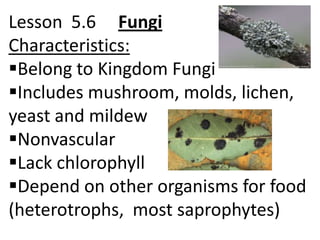Biology Lesson 5.6
•Télécharger en tant que PPTX, PDF•
5 j'aime•688 vues
Signaler
Partager
Signaler
Partager

Recommandé
Contenu connexe
Tendances
Tendances (20)
Bacteria versus fungi, Difference between bacteria and fungi

Bacteria versus fungi, Difference between bacteria and fungi
Bacteria versus virus, Difference between bacteria and virus

Bacteria versus virus, Difference between bacteria and virus
En vedette (6)
Kingdom Protista, Protist Biology Lesson PowerPoint

Kingdom Protista, Protist Biology Lesson PowerPoint
Similaire à Biology Lesson 5.6
Similaire à Biology Lesson 5.6 (20)
Plus de Kelley Crawford
Plus de Kelley Crawford (20)
Biology Lesson 5.6
- 1. Lesson 5.6 Fungi Characteristics: Belong to Kingdom Fungi Includes mushroom, molds, lichen, yeast and mildew Nonvascular Lack chlorophyll Depend on other organisms for food (heterotrophs, most saprophytes)
- 2. Lesson 5.6 Fungi Characteristics: Most multicelled except yeast Have filaments that make up the body called hyphae Hyphae together make up the main body called the mycelium
- 3. Lesson 5.6 Fungi Terms: Heterotrophs – organisms that can not produce their own food. Autotrophs – organisms that can make their own food. Saprophytes – get nutrients from dead organisms
- 4. Lesson 5.6 Fungi Terms: Mycologist – scientist who studies fungi
- 5. Lesson 5.6 Fungi Importance of Fungi: Great decomposers Some parasitic Yeast important to bread making Mushrooms people like to eat Penicillin – important class of antibiotics
- 6. Lesson 5.6 Fungi Types of fungi: 1. Club Fungi Produce spores in microscopic club- shaped structures called basidia Includes mushrooms, toadstools, rust and smuts Saprophytes Many edible
- 8. Lesson 5.6 Fungi Types of fungi: 1. Club Fungi Many rust and smuts cause great crop damage ex. Wheat rust and corn smut 2. Molds Ex. Bread mold, cheese mold Penicillin comes from Penicillium mold Some harmful to crops
- 10. Lesson 5.6 Fungi Types of fungi: 1. Club Fungi 2. Molds 3. Sac Fungi Have saclike spore-producing structures Ex. Yeast and mildew Carry out alcoholic fermentation produce CO2 makes bread rise
- 11. Lesson 5.6 Fungi Types of fungi: 1. Club Fungi 2. Molds 3. Sac Fungi Reproduces by budding when conditions are good and spores called ascus when conditions bad and can remain dormant.
- 12. Lesson 5.6 Fungi Types of fungi: 1. Club Fungi 2. Molds 3. Sac Fungi 4. Slime molds Jellylike organisms found on bark of fallen trees Brightly colored (bright red, yellow, orange) Eat bacteria or other organic stuff
- 14. Lesson 5.6 Fungi Types of fungi: 1. Club Fungi 2. Molds 3. Sac Fungi 4. Slime molds 5. Lichens Symbiotic relationship between algae and fungus Algae is photosynthetic and provides food Fungus provides water and minerals for algae
